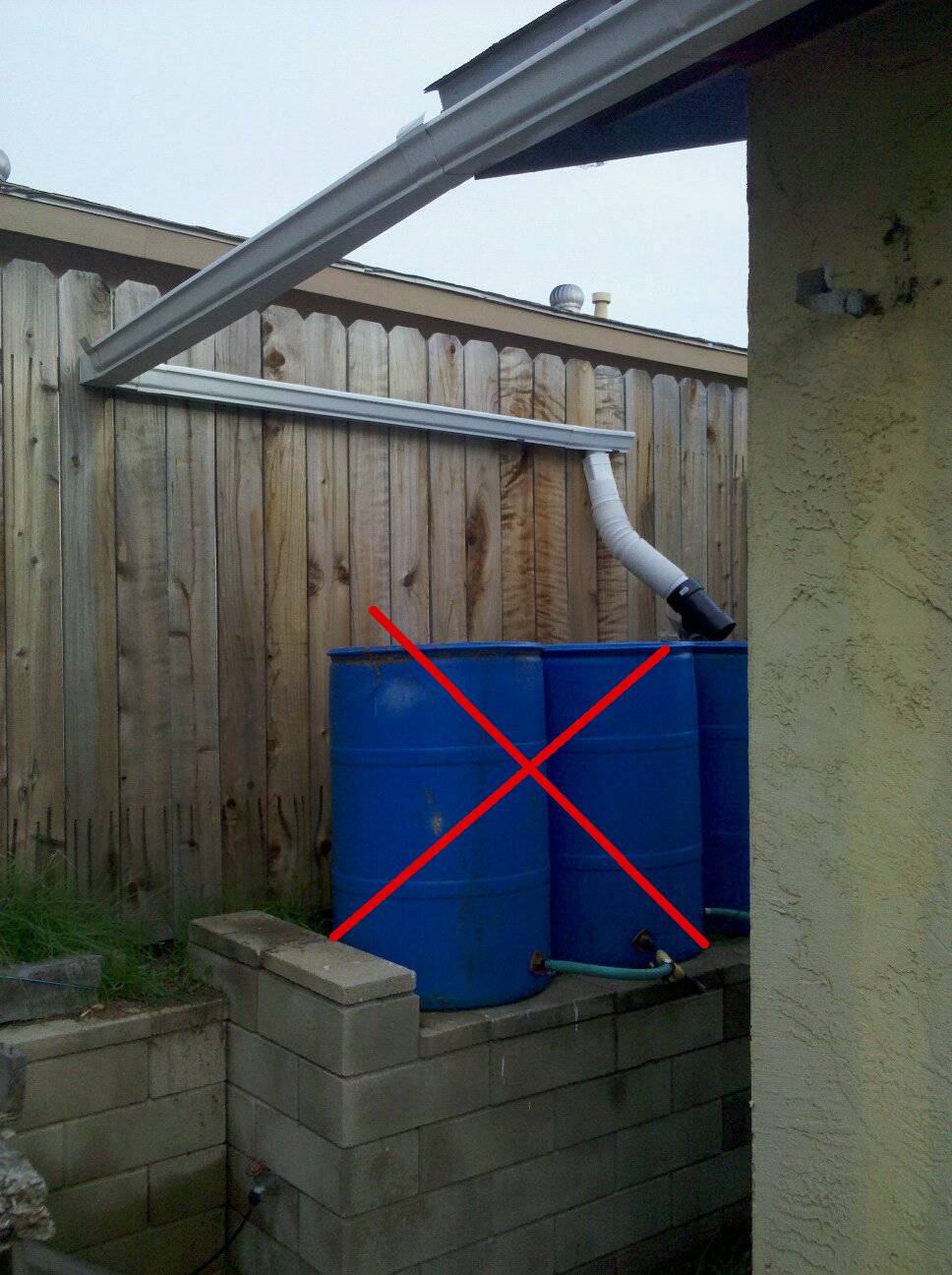 Cheap Rain catchment (still isn't worth it)
Cheap Rain catchment (still isn't worth it)
 Cheap Rain catchment (still isn't worth it)
Cheap Rain catchment (still isn't worth it)
55 gallon food grade barrels from freecycle: $0. old hose, hose ends, and bungs from Home Depot <$10. The PVC elbow has a fine screen and is attached to one hole in the center barrel (I've moved it since this photo) and that feeds the other two. All sealed and up on a 3' retaining wall so they gravity feed anywhere in the back yard. Just 165 gallons.
We needed to replace the rain gutter anyway, so we are not counting the cost of that, but to extend an existing gutter, it would have cost about $50. PVC pipe or other low cost tubing could have been run from a standard down spout into the barrels, but that wouldn't have allowed the height of the barrels, and since you have to buy the stuff in fixed lengths, we ended up with more rain gutter than we needed, so we just had to buy one corner extra to get it over to the fence and into place for the down spout right over the barrels.
But actually, to look at it literally, that water is worth about nothing. At a rate of less than $5 per thousand gallons at the very most, that 165 gallons of rain water is worth far less than $1. This ultra low cost catchment might pay for itself in a year or two.
That's why spending $100 or even $1000 on rain water catchment the way the "greenwashers" want you to do. It sooooo isn't worth doing. Sustainablility = Frugality over Time. If it doesn't save money, it isn't freking green. Period.
And let's talk about the plastic. Those barrels are well made, with UV resistant plasticizers baked in... which are toxic. And eventually, they WILL break down, become brittle, and crack. It might take 20 years, but it's gonna happen. So Rain Barrels = more plastics in the environment.
And the water stored above ground in the open is an invitation to mosquitoes (and the netting will break eventually) and to bacteria and fungus and mold and all the bag things that happen to stagnant water.
Rain barrels are a bad idea.
A much better way to collect and store rain water is with a Swale. Swales^ are areas that collect rain and other water so that it has time to seep into the ground instead of running off.
It turns out that swales can allow an enormous amount of water to be absorbed by the earth and retained for trees and other deep root plants. ^ And they don't have to look bad, because they can be hidden below mulch. The mulch will sop up the water and hold it safely. It won't attract mosquitoes or bad bacteria and will prevent it from evaporating.
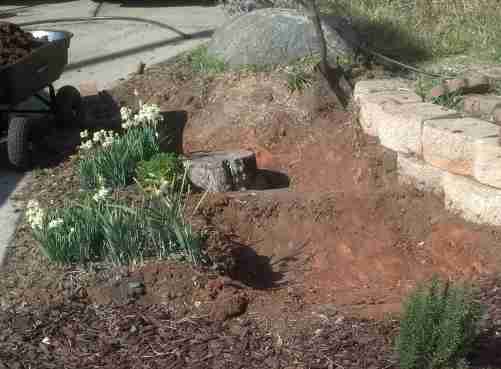 Digging out the swale "ponds." The water will collect
in those spaces after running off the lawn and the roof during rain storms.
Or if someone accidentally leaves the hose on... :ahem:
Digging out the swale "ponds." The water will collect
in those spaces after running off the lawn and the roof during rain storms.
Or if someone accidentally leaves the hose on... :ahem:
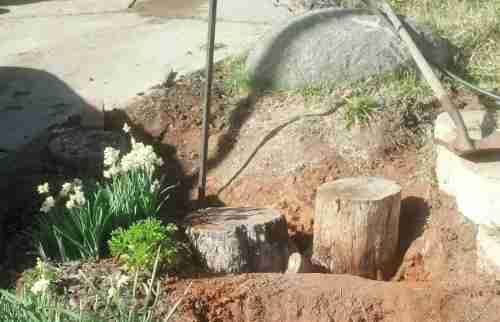
Adding old logs to provide stepping "stones" to walk over and to provide a home for microorganisms and to act as a sponge.
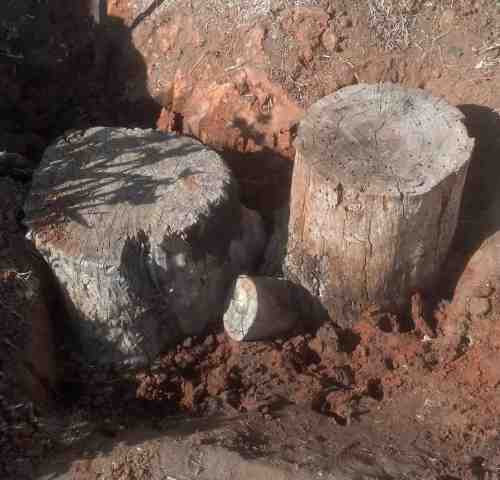
It's hard to see how deep that is, but there is quite a bit of volumn for water to build up.
Top bed filled in around the stumps. Fine mulch in the bottom
bed.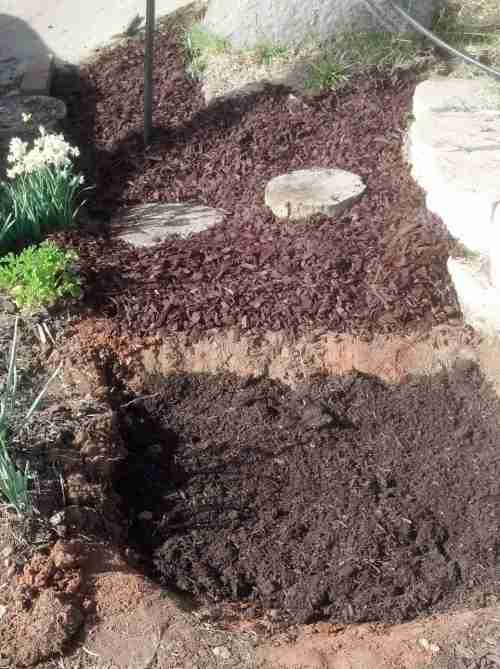
Finished project. The red edging bricks in the foreground will be replaced
with nicer stepping
stones.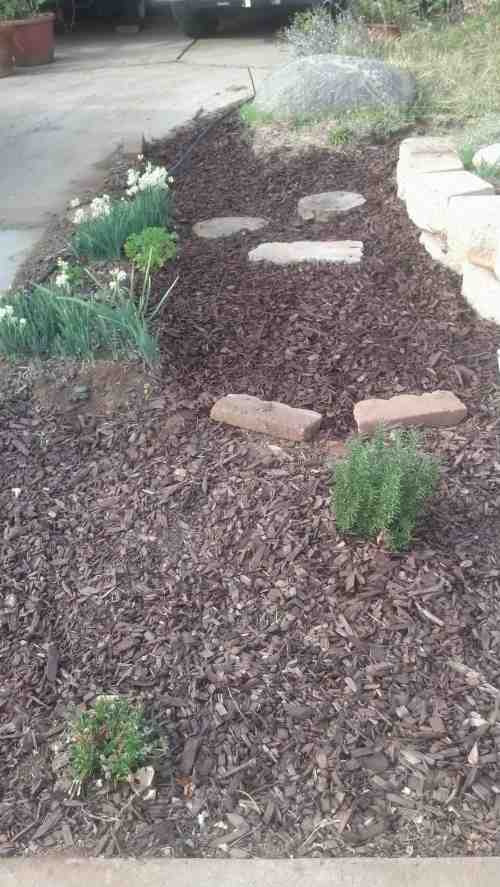
Also:
See also:
Now, in all fairness, a lot of that collected water is going to seep down into the earth, and eventually trickle down into the water table; I won't get ALL of it back during the dry spell that will certainly follow. But the mulch does sponge up a lot, and at a much lower price / gallon (almost zero). And it releases it automatically into the soil around each swale. And I'm feeding the water table, and saving the cities already overtaxed storm water system the extra load of processing that water. +
James Newton of MassMind Says:
Using plastic to store water is just putting more plastic into the environment, giving the water a chance to go bad, and wasting money. Rain water should be held in swales. In mulch, or compost, or hay, or sticks and branches (as in hugelkultur). Then the water will not go bad, it will seep out into the beds on either side, slowly, and automatically watering your plants. And the cost is only labor. Which is good for you, or good for you to pay for because it's good for a worker. And best of all... you aren't putting more.... fricking plastic into the world!+
Questions:
| file: /Techref/other/rainwater.htm, 9KB, , updated: 2020/6/28 16:28, local time: 2025/6/29 04:45,
216.73.216.196,10-1-0-7:LOG IN
|
| ©2025 These pages are served without commercial sponsorship. (No popup ads, etc...).Bandwidth abuse increases hosting cost forcing sponsorship or shutdown. This server aggressively defends against automated copying for any reason including offline viewing, duplication, etc... Please respect this requirement and DO NOT RIP THIS SITE. Questions? <A HREF="http://sxlist.com/techref/other/rainwater.htm"> Rain Water Catchment</A> |
| Did you find what you needed? |
Welcome to sxlist.com!sales, advertizing, & kind contributors just like you! Please don't rip/copy (here's why Copies of the site on CD are available at minimal cost. |
|
Ashley Roll has put together a really nice little unit here. Leave off the MAX232 and keep these handy for the few times you need true RS232! |
.